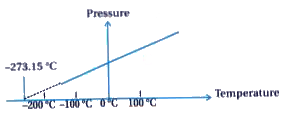Explain constant volume gas thermometer and absolute zero temperature. Solution in Gujrati
Liquid-in-glass thermometers show different readings for temperatures other than the fixed points because of differing expansion properties.
A thermometer that uses a gas, however, gives the same readings regardless of which gas is used.
Experiments show that all gases at low densities exhibit same expansion behaviour. The variables that describe the behaviour. The variables that describe the behaviour of a given quantity (mass) of gas are pressure, volume and temperature (P, V and T) where T=t+273.15,t is the temperature in ∘C.
Boyle.s law : When temperature is held constant the pressure and volume of a quantity of gas are related as PV = constant. This relationship was discovered by Robert Boyle (1627-1691).
Charle.s law : When the pressure is held constant, the volume of a quantity of the gas is related to the temperature as VT= constant. This relationship was discovered by Jacques Charles (1747-1823).
Low density gases obey these laws, which may be combined into a single relationship. PV/T should also be a constant. This relationship is known as ideal gas law.
It can be written in a more general form that applies not just to a given quantity of a single gas but to any quantity of any dilute gas.
Ideal - gas equation :
PVT=μR
or PV=μRT . . . (1)
where, μ is the number of moles in the sample of gas and R is called universal gas constant :
R=8.31 J mol−1K−1
μ and R are constant in equation (1)
∴PV∝T
This relationship allows a gas to be used to measure temperature in a constant volume gas thermometer. Holding the volume of a gas constant, it gives P∝T.
Thus, with a constant-volume gas thermometer temperature is read in terms of pressure. A plot of pressure versus temperature gives a straight line in this case.

However, measurements on real gases deviate from the values predicted by ideal gas law at low temperature. But the relationship is linear over a large temperature range.
It looks a though the pressure might reach zero with decreasing temperature if the gas continued to be a gas. The absolute minimum temperature for an ideal gas, there, inferred by extrapolating the straight line to the axis, as in temperature is found to be −273.15 ∘C and is designated as absolute zero.

Absolute zero is the foundation of the Kelvin temperature scale or absolute scale temperature named after the British scientist Lord Kelvin.
On this scale, −273.15 ∘C is taken as the zero point, that is 0 K.
Topper's Solved these Questions
- THERMAL PROPERTIES OF MATTERBOOK - KUMAR PRAKASHANCHAPTER - THERMAL PROPERTIES OF MATTEREXERCISE - Try Yourself (VSQs)
84 Videos
- THERMAL PROPERTIES OF MATTERBOOK - KUMAR PRAKASHANCHAPTER - THERMAL PROPERTIES OF MATTEREXERCISE - Information : Higher Order Thinking Skills (HOTS)
8 Videos
- SYSTEMS OF PARTICLES AND ROTATIONAL MOTIONBOOK - KUMAR PRAKASHANCHAPTER - SYSTEMS OF PARTICLES AND ROTATIONAL MOTIONEXERCISE - SECTION-F (SECTION-D) QUESTIONS PAPER
1 Videos
- THERMODYANMICS BOOK - KUMAR PRAKASHANCHAPTER - THERMODYANMICS EXERCISE - Question Paper
11 Videos
Similar Questions
''Amount of heat is greater in hot body than cold body''. Check correctness of this statement.
View SolutionWhat is the triple point ?
View SolutionA rope of negligible mass is wound round a hollow cylinder of mass 3 kg and radius 40 cm. What is the angular acceleration of the cylinder if the rope is pulled with a force of 30 N? What is the linear acceleration of the rope? Assume that there is no slipping.
View SolutionWhy is a steam burn more damaging than a burn with boiling water of the same ?
View SolutionA constant volume gas thermometer works on
View SolutionWhat is the volume of a gas at absolute zero of temperature ?
View SolutionWhat is volume of ideal gas at absolute zero temperature?
View SolutionThe motion of gas molecules ceases at the temperature of absolute zero .Explain.
View SolutionA constant volume gas thermometer works on
View SolutionA temperature is measured by a constant volume gas thermometer
View SolutionIn a constant volume gas thermometer, the temperature of a bath is measured by
View SolutionA temperature is measured by a constant volume gas thermometer.
View SolutionA constant volume gas thermometer works on
View SolutionThe temperature measured by a constant volume gas thermometer approaches that of an ideal gas temperature scale when the gas is at a
View SolutionA constant volume gas thermometer is preferred over a constant pressure gas thermometer as
View Solution
